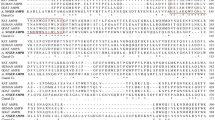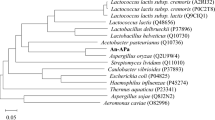Abstract
A leucine aminopeptidase Lap1 was cloned from Aspergillus sojae GIM3.30. The truncated Lap1 without a signal peptide was over-expressed in P. pastoris, and the enzymatic characteristics of recombinant Lap1 (rLap1) were tested. The rLap1 was about 36.7 kDa with an optimal pH 8.0 and optimal temperature 50 °C for substrate Leu-p-nitroanilide and it sustained 50 % activity after 1 h incubation at 50 °C. The activity of rLap1 was significantly inhibited by EDTA, whereas Co2+, Mn2+, and Ca2+ ions, but not Zn2+ ions, restored its activity. rLap1 showed the highest activity against Arg-pNA and then Leu-, Lys-, Met-, and Phe-pNA. The 3D structure of rLap1 showed it had a conserved functional charge/dipole complex and a hydrogen bond network of Zn2-D179-S228-Q177-D229-S158 around its active center. An acidic Asp residue was found at the bottom of the substrate binding pocket, which explains its preference for basic N-terminal amino acid substrates such as Arg and Lys. rLap1 improved the degree of hydrolysis of casein and soy protein hydrolysates and also decreased their bitterness, indicating its potential utility in food production.






Similar content being viewed by others
References
Hersh, L. B., Aboukhair, N., & Watson, S. (1987). Immunohistochemical localization of aminopeptidase M in rat brain and periphery: relationship of enzyme localization and enkephalin metabolism. Peptides, 8, 523–532.
Park, H., Shim, J. S., Kim, B. S., Jung, H. J., Huh, T.-L., & Kwon, H. J. (2014). Purpurin inhibits adipocyte-derived leucine aminopeptidase and angiogenesis in a zebrafish model. Biochemical and Biophysical Research Communications, 450, 561–567.
Gonzales, T., & Robert-Baudouy, J. (1996). Bacterial aminopeptidases: properties and functions. FEMS Microbiology Reviews, 18, 319–344.
Xi, H., Tian, Y., Zhou, N., Zhou, Z., & Wei, S. (2014). Characterization of an N -glycosylated Bacillus subtilis leucine aminopeptidase expressed in Pichia pastoris. Journal of Basic Microbiology, 55, 236–246.
Kusumoto, K. I., Matsushita-Morita, M., Furukawa, I., Suzuki, S., Yamagata, Y., Koide, Y., Ishida, H., Takeuchi, M., & Kashiwagi, Y. (2008). Efficient production and partial characterization of aspartyl aminopeptidase from Aspergillus oryzae. Journal of Applied Microbiology, 105, 1711–1719.
Ramírez-Zavala, B., Mercado-Flores, Y., Hernández-Rodríguez, C., & Villa-Tanaca, L. (2004). Purification and characterization of a lysine aminopeptidase from Kluyveromyces marxianus. FEMS Microbiology Letters, 235, 369–375.
Rawlings, N. D., Barrett, A. J., & Bateman, A. (2012). MEROPS: the database of proteolytic enzymes, their substrates and inhibitors. Nucleic Acids Research, 40, D343–D350.
Duprez, K., Scranton, M. A., Walling, L. L., & Fan, L. (2014). Structure of tomato wound-induced leucine aminopeptidase sheds light on substrate specificity. Acta Crystallographica, 70, 1649–1658.
Matsui, M., Fowler, J. H., & Walling, L. L. (2006). Leucine aminopeptidases: diversity in structure and function. Biological Chemistry, 387, 1535–1544.
Stressler, T., Eisele, T., Schlayer, M., Lutz-Wahl, S. and Fischer, L. (2013). Characterization of the recombinant exopeptidases pepx and pepn from Lactobacillus helveticus ATCC 12046 important for food protein hydrolysis. Plos One, 8, −.
Nampoothiri, K. M., Nagy, V., Kovacs, K., Szakacs, G., & Pandey, A. (2005). L-leucine aminopeptidase production by filamentous Aspergillus fungi. Letters in Applied Microbiology, 41, 498–504.
Lin, L.-L., Hsu, W.-H., Wu, C.-P., Chi, M.-C., Chou, W.-M., & Hu, H.-Y. (2004). A thermostable leucine aminopeptidase from Bacillus kaustophilus CCRC 11223. Extremophiles, 8, 79–87.
Shen, Y., Wang, F., Lan, D., Liu, Y., Yang, B., & Wang, Y. (2011). Biochemical properties and potential applications of recombinant leucine aminopeptidase from Bacillus kaustophilus CCRC 11223. International Journal of Molecular Sciences, 12, 7609–7625.
Rahulan, R., Dhar, K., Nampoothiri, K., & Pandey, A. (2012). Aminopeptidase from Streptomyces gedanensis as a useful tool for protein hydrolysate preparations with improved functional properties. Journal of Food Science, 77, C791.
Nakadai, T., Nasuno, S., & IGUCHI, N. (1973). Purification and properties of leucine aminopeptidase I from Aspergillus oryzae. Agricultural and Biological Chemistry, 37, 757–765.
NAKADAI, T., & NASUNO, S. (1977). Purification and properties of leucine aminopeptidase IV from Aspergillus oryzae. Agricultural and Biological Chemistry, 41, 1657–1666.
Chien, H. C. R., Lin, L. L., Chao, S. H., Chen, C. C., Wang, W. C., Shaw, C. Y., Tsai, Y. C., Hu, H. Y., & Hsu, W. H. (2002). Purification, characterization, and genetic analysis of a leucine aminopeptidase from Aspergillus sojae. Biochimica et Biophysica Acta, 1576, 119–126.
Machida, M., Asai, K., Sano, M., Tanaka, T., Kumagai, T., Terai, G., Kusumoto, K., Arima, T., & Akita, O. (2005). Genome sequencing and analysis of Aspergillus oryzae. Nature, 438, 1157–1161.
Sato, A., Oshima, K., Noguchi, H., Ogawa, M., Takahashi, T., Oguma, T., Koyama, Y., Itoh, T., Hattori, M., & Hanya, Y. (2011). Draft genome sequencing and comparative analysis of Aspergillus sojae NBRC4239. DNA Research, 18, 165–176.
Matsushita-Morita, M., Tada, S., Suzuki, S., Hattori, R., Marui, J., Furukawa, I., Yamagata, Y., Amano, H., Ishida, H., Takeuchi, M., Kashiwagi, Y., & Kusumoto, K.-I. (2011). Overexpression and characterization of an extracellular leucine aminopeptidase from Aspergillus oryzae. Current Microbiology, 62, 557–564.
Gotou, T., Shinoda, T., Mizuno, S., & Yamamoto, N. (2009). Purification and identification of proteolytic enzymes from Aspergillus oryzae capable of producing the antihypertensive peptide Ile-Pro-Pro. Journal of Bioscience and Bioengineering, 107, 615.
Chevrier, B., D’orchymont, H., Schalk, C., Tarnus, C., & Moras, D. (1996). The structure of the Aeromonas proteolytica aminopeptidase complexed with a hydroxamate inhibitor. European Journal of Biochemistry, 237, 393–398.
Hanaya, K., Suetsugu, M., Saijo, S., Yamato, I., & Aoki, S. (2012). Potent inhibition of dinuclear zinc (II) peptidase, an aminopeptidase from Aeromonas proteolytica, by 8-quinolinol derivatives: inhibitor design based on Zn2+ fluorophores, kinetic, and X-ray crystallographic study. JBIC, Journal of Biological Inorganic Chemistry, 17, 517–529.
Fundoiano-Hershcovitz, Y., Rabinovitch, L., Langut, Y., Reiland, V., Shoham, G., & Shoham, Y. (2004). Identification of the catalytic residues in the double-zinc aminopeptidase from Streptomyces griseus. FEBS Letters, 571, 192–196.
Juárez-Montiel, M., Ibarra, J. A., Chávez-Camarillo, G., Hernández-Rodríguez, C., & Villa-Tanaca, L. (2014). Molecular cloning and heterologous expression in Pichia pastoris of x-prolyl-dipeptidyl aminopeptidase from basidiomycete Ustilago maydis. Applied Biochemistry and Biotechnology, 172, 2530–2539.
Tan, P., & Konings, W. (1990). Purification and characterization of an aminopeptidase from Lactococcus lactis subsp. cremoris Wg2. Applied and Environmental Microbiology, 56, 526–532.
Karadzic, I., Izrael, L., Gojgic-Cvijovic, G., & Vujcic, Z. (2002). Leucine aminopeptidase from Streptomyces hygroscopicus is controlled by a low molecular weight inhibitor. Journal of Bioscience and Bioengineering, 94, 309.
Ke, Y., Huang, W.-Q., Li, J.-Z., Xie, M.-Q. and Luo, X.-C. (2012). Enzymatic characteristics of a recombinant neutral protease I (rNpI) from Aspergillus oryzae expressed in Pichia pastoris. Journal of Agricultural and Food Chemistry, 60, 12164–12169.
Damle, M., Harikumar, P., & Jamdar, S. (2010). Debittering of protein hydrolysates using immobilized chicken intestinal mucosa. Process Biochemistry, 45, 1030–1035.
Desmarais, W., Bienvenue, D. L., Bzymek, K. P., Petsko, G. A., Ringe, D., & Holz, R. C. (2006). The high-resolution structures of the neutral and the low pH crystals of aminopeptidase from Aeromonas proteolytica. JBIC, Journal of Biological Inorganic Chemistry, 11, 398–408.
Overington JP, Zhu, ZY., Sali A, Johnson MS, Sowdhamini R, Louie GV, Blundell TL, (1993). Molecular recognition in protein families: a database of aligned three-dimensional structures of related proteins. Biochemical Society Transactions, 3, 597-604.
MacKerell, A. D., Brooks, B., Brooks, C. L., Nilsson, L., Roux, B., Won, Y. and Karplus, M. (2002), in Encyclopedia of Computational Chemistry, John Wiley & Sons, Ltd.
Bzymek, K. P., Moulin, A., Swierczek, S. I., Ringe, D., Petsko, G. A., Bennett, B., & Holz, R. C. (2005). Kinetic, spectroscopic, and X-ray crystallographic characterization of the functional E151H aminopeptidase from Aeromonas proteolytica. Biochemistry, 44, 12030–12040.
Ataie, N., Hoang, Q., Zahniser, M., Tu, Y., Milne, A., Petsko, G., & Ringe, D. (2008). Zinc coordination geometry and ligand binding affinity: the structural and kinetic analysis of the second-shell serine 228 residue and the methionine 180 residue of the aminopeptidase from Vibrio proteolyticus. Biochemistry, 47, 7673–7683.
Wagner, F. W., Wilkes, S. H., & Prescott, J. M. (1972). Specificity of Aeromonas aminopeptidase toward amino acid amides and dipeptides. Journal of Biological Chemistry, 247, 1208–1210.
Acknowledgments
This work was financially supported by Guangdong Province of China Science and Technology Projects (Project No. 2012B020311003, No. 2013B010404003, No. 2014A010107005).
Author information
Authors and Affiliations
Corresponding author
Rights and permissions
About this article
Cite this article
Huang, WQ., Zhong, LF., Meng, ZZ. et al. The Structure and Enzyme Characteristics of a Recombinant Leucine Aminopeptidase rLap1 from Aspergillus sojae and Its Application in Debittering. Appl Biochem Biotechnol 177, 190–206 (2015). https://doi.org/10.1007/s12010-015-1737-5
Received:
Accepted:
Published:
Issue Date:
DOI: https://doi.org/10.1007/s12010-015-1737-5




